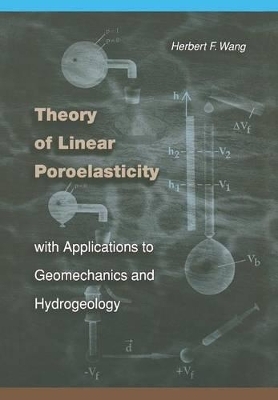
Theory of Linear Poroelasticity with Applications to Geomechanics and Hydrogeology
Princeton University Press (Verlag)
978-0-691-03746-2 (ISBN)
The theory of linear poroelasticity describes the interaction between mechanical effects and adding or removing fluid from rock. It is critical to the study of such geological phenomena as earthquakes and landslides and is important for numerous engineering projects, including dams, groundwater withdrawal, and petroleum extraction. Now an advanced text synthesizes in one place, with one notation, numerous classical solutions and applications of this highly useful theory. The introductory chapter recounts parallel developments in geomechanics, hydrogeology, and reservoir engineering that are unified by the tenets of poroelasticity. Next, the theory's constitutive and governing equations and their associated material parameters are described. These equations are then specialized for different simplifying geometries: unbounded problem domains, uniaxial strain, plane strain, radial symmetry, and axisymmetry. Example problems from geomechanics, hydrogeology, and petroleum engineering are incorporated throughout to illustrate poroelastic behavior and solution methods for a wide variety of real-world scenarios.
The final chapter provides outlines for finite-element and boundary-element formulations of the field's governing equations. Whether read as a course of study or consulted as a reference by researchers and professionals, this volume's user-friendly presentation makes accessible one of geophysics' most important subjects and will do much to reduce poroelasticity's reputation as difficult to master.
Herbert F. Wang is Professor of Geophysics at the University of Wisconsin-Madison and coauthor of Introduction to Groundwater Modeling: Finite Difference and Finite Element Methods. His research interests have included the poroelastic properties of rocks, the poroelastic theory of fractured rocks, and the poroelastic modeling of ground deformations following earthquakes.
Preface xi Chapter 1: Introduction 3 1.0 Chapter Overview 3 1.1 Historical Examples 3 1.2 Basic Concepts 5 1.3 Brief History 8 1.4 Geomechanics 8 1.5 Hydrogeology 10 1.6 Petroleum Engineering 13 1.7 Biot's Theory 14 1.8 Preview of Constitutive Relations 17 1.9 Thermoelastic Analogy 22 Chapter 2: Linear Constitutive Equations 26 2.0 Chapter Overview 26 2.1 Kinematic Variables 26 2.2 Dynamic Variables 30 2.3 Constitutive Relations 31 2.4 Principal Coordinates 33 2.5 Isotropic Stress and Strain 34 2.6 Nonprincipal Coordinates 37 2.7 Anisotropy 42 2.8 Effective Stress 43 3. Poroelastic Constants 47 Chapter 3: Chapter Overview 47 3.1 Compressibility 47 3.2 Drained versus Undrained Moduli 53 3.3 Storage Capacity 55 3.4 Hydraulic Diffusivity 61 3.5 Poroelastic Expansion Coefficients 62 3.6 Coefficients of Undrained Pore-Pressure Buildup 64 3.7 Incompressible or Highly Compressible Constituents 68 3.8 Laboratory Data 69 Chapter 4: Governing Equations 71 4.0 Chapter Overview 71 4.1 Force Equilibrium Equations 72 4.2 Displacement Formulation 73 4.3 Beltrami-Michell Equations 76 4.4 Strain Compatibility Equations 77 4.5 Mechanical Boundary and Initial Conditions 78 4.6 Darcy's Law 79 4.7 Fluid Continuity 83 4.8 Comparison of Diffusion Equations 86 4.9 Fluid Boundary and Initial Conditions 87 4.10 Uncoupling of Stress or Strain from Pore Pressure 88 4.11 Force Equilibrium for the Solid Matrix 91 Chapter 5: Unbounded Problem Domains 96 5.0 Chapter Overview 96 5.1 Poroelastic Displacement Potential in Infinite Domain 96 5.2 Uniform Fluid Injection in a Sphere 98 5.3 Green's Functions 101 5.4 Center of Dilatation 103 5.5 Half Space with Traction-Free Boundary 105 5.6 Gravity Analogy 107 5.7 Sudden Injection of Fluid at a Point in Infinite Domain 110 5.8 Fluid Dipole Equivalence to Body-Force Distributions 112 Chapter 6: Uniaxial Strain 116 6.0 Chapter Overview 116 6.1 Constitutive Equations 116 6.2 Force Equilibrium Equation 118 6.3 Fluid Diffusion Equation 119 6.4 Step Load on Semi-Infinite Column 120 6.5 Consolidation of a Finite Layer (Terzaghi's Problem) 124 6.6 Uniformly Increasing Load on a Finite Layer 129 6.7 Sedimentation on Impermeable Basement 131 6.8 Erosional Unloading 134 6.9 Periodic Load on a Half Space 136 6.10 Periodic Load on a Finite Layer 138 6.11 Water Load on a Half Space 140 Chapter 7: Plane Strain and Plane Stress in Rectangular Coordinates 150 7.0 Chapter Overview 150 7.1 Constitutive Equations for Plane Strain 151 7.2 Governing Equations for Plane Strain 151 7.3 Mandel's Problem 153 7.4 Biot's Stress Function 157 7.5 Periodic Load on a Half Space 158 7.6 Displacement Functions 163 7.7 Sudden Step Load on a Half Space 165 7.8 Undrained Response to a Line Source 170 7.9 Sudden Fault Slip 172 7.10 Constitutive Equations for Plane Stress 183 8. Plane Strain in Polar Coordinates 187 Chapter 8: Chapter Overview 187 8.1 Radial Symmetry 187 8.2 Sudden Pressurization of a Long Cylinder 191 8.3 Sudden Pressurization of a Borehole 201 8.4 Sudden Stress Release due to Borehole Excavation in an Anisotropic Stress Field 203 8.5 Hydraulic Fracturing 205 8.6 Sudden Internal Pressurization of a Hollow Cylinder 206 8.7 Line Source in Plane Strain 211 Chapter 9: Axisymmetry 215 9.0 Chapter Overview 215 9.1 Governing Equations 215 i 9.2 Pumping from a Well 216 9.3 Reverse Water-Level Fluctuations 218 9.4 Pulse-Decay Test 221 9.5 Elastostatic Subsidence of a Half Space 226 9.6 Time-Dependent Subsidence of a Half Space 229 Chapter 10: Numerical Methods 238 10.0 Chapter Overview 238 10.1 Finite-Element Method 238 10.2 Boundary-Element Method 245 Appendix A: Integral Transforms 257 A.1 Properties of Fourier Transforms 257 A.2 Properties of Laplace Transforms 258 A.3 Stehfest Algorithm for Laplace Transform Inversion 259 A.4 Properties of Hankel Transforms 260 Appendix B: Relations Among Poroelastic Constants 262 Appendix C: Representative Poroelastic Constants 265 Symbols 267 References 269 Uniited References 279 Author Index 283 Subject Index 286
| Erscheint lt. Verlag | 3.12.2000 |
|---|---|
| Reihe/Serie | Princeton Series in Geophysics |
| Zusatzinfo | 11 tables, 83 line illus |
| Verlagsort | New Jersey |
| Sprache | englisch |
| Maße | 152 x 235 mm |
| Gewicht | 567 g |
| Themenwelt | Naturwissenschaften ► Geowissenschaften ► Geologie |
| Naturwissenschaften ► Geowissenschaften ► Geophysik | |
| Technik ► Bauwesen | |
| ISBN-10 | 0-691-03746-9 / 0691037469 |
| ISBN-13 | 978-0-691-03746-2 / 9780691037462 |
| Zustand | Neuware |
| Haben Sie eine Frage zum Produkt? |
aus dem Bereich


